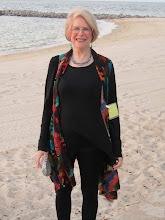 |
| Frescoes painted on outside of palace |
 |
| These aren't small |
The weather in Genoa was the opposite extreme to the UK. We had above normal temperatures and humidity. Normal temperature for this time of year is around 75. It was in the high 80's and low 90's. The days excursion was going to be a walking tour of the old part of Genoa. We were to meet at a square near Via Garabaldi which my hotel told me was a 5 minute walk. With map in hand, I set out. It was a good thing I left early.... 15 minutes later after huffing and puffing uphill and downhill I arrived wondering if I were going to last the whole day! The 8 of us managed to find each other from our scattered hotels and we waited for our guide. The architecture is both imposing and impressive. The artwork on the palaces is mind boggling. A fortune, even in those days, was spent on these building. There is a combination of sculpture, paintings, and tromp l'oeil, on the facades of all these buildings. One of the stories our guide told us had to do with the "Sunshine" tax imposed by Napoleon Bonaparte. There was a special tax that had to be paid for every window in a building. In order to maintain the symmetry of the structure and design, fake windows were painted on the facades and the tax was avoided. Two of the old palaces had been turned into museums but we were not going to have time to see them today. (This turned into tomorrow's outing for some of us since we had no official plans).
The alleys in Genoa resemble those in Venice.... narrow, dark, serpentine, and full of surprises. We ogled the store windows, vegetable markets, meat markets, and candy shops. Our next destination was to have been the Cathedral of San Lorenzo but it closed at 12.00 and was not going to reopen till 3:00. Lunch was scheduled for 1:00. There was another church nearby that would be open till 1:00. Everything shuts down in the afternoon and reopens at 3:00 or 4:00 p.m. Lunch was in this really weird restaurant. The decor was posters and memorabilia of movies from the 1950's. So was the music. I will stand on record stating that I am not fond of Elvis.... please don't shoot me. The food, thankfully was pure Italian and delicious. Pesto is one of the local regional specialties and our first course was loaded with it.
 |
| Piazza de Ferrari |
 |
| Porto Soprana |
 |
| San Lorenzo |
The interior of the church is stunning. No expense was spared here. There is still a lot of restoration work going on and you can see the old fresco's that were painted on the walls.
They used a combination of marble and slate to get the bands of color.
Bicycles are not very common here but cars are not very practical either. In a population of 700,000 there are more than 200,000 motorcycles and motorbikes. They are really the only practical way of getting around such a hilly city
I was pooped by this time and still had to hike my way back to my hotel. Most of us opted to call it quits for the day and some of us decided to get together the next morning and explore some of the places we did not have time to do today. There were no official plans for dinner. Ned and I ate at a lovely restaurant overlooking the sea.













1 comment:
that plant you asked about looks like a gourd plant to me. if you google "gourd plants" under images, you'll see some similar plants.
Post a Comment